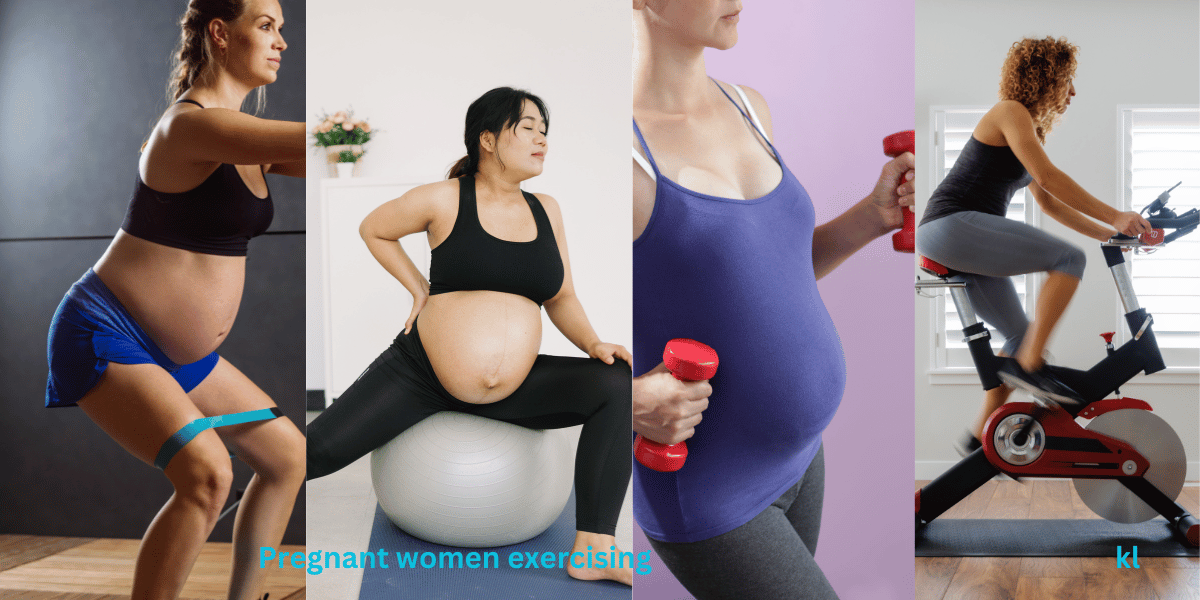Exercising during pregnancy might seem intimidating, but the right prenatal workouts can make a huge difference in keeping you strong, flexible, and feeling good as your body changes.
According to the National Library of Medicine, Women who exercise during pregnancy have a low probability of developing gestational diabetes mellitus. The American College of Obstetricians and Gynecologists also found out that exercising during pregnancy can reduce back pain by up to 40%.
In this guide, we’ll explore safe, trimester-specific exercises you can try no matter your fitness level. Whether you’re new to working out or already love to stay active, these routines focus on keeping you and your baby safe while boosting your health.
- Benefits of Exercising During Pregnancy for Mom and Baby
- Safety First: Guidelines for Exercising While Pregnant
- First Trimester Exercises: Building a Foundation
- Second Trimester Workouts: Maintaining Strength and Balance
- Third Trimester Exercises: Focusing on Comfort and Mobility
- Modifications for Common Pregnancy Discomforts
- Best Prenatal Equipment for Safe Workouts
- Setting Up a Safe, Comfortable Workout Space
- When to Avoid or Stop Prenatal Exercise
Benefits of Exercising During Pregnancy for Mom and Baby
First off, let’s talk about circulation. I remember one morning when I felt like my legs had taken a vacation — hello, morning sickness! I decided to go for a gentle walk, and just 20 minutes later, I felt like I had a whole new body.
Increasing blood flow through light exercise does wonders, delivering oxygen and nutrients to both mom and baby. This not only eases aches but can also reduce swelling, especially in the ankles and feet.
Exercise can also help manage weight gain and maintain healthy blood sugar levels, which lowers the risk of gestational diabetes.
Plus, babies born to moms who exercise tend to have better heart health, too — who knew a few squats could impact the little one’s heart rate and even brain development? Knowing this gave me a new sense of purpose every time I moved my body.
Circulation, Energy, and Sleep — The Trifecta of Prenatal Workouts
Pregnancy comes with its share of discomforts. You know, the midday crash, random leg cramps, and yes, the nightly struggle to get comfortable in bed.
Safe prenatal exercises help alleviate these issues by working directly on circulation, which in turn improves energy levels and leads to better sleep.
Pregnancy fatigue is real, but regular workouts counter it by promoting better blood flow and oxygen levels. Low-impact cardio exercises, like walking or swimming, are excellent for this.
Core Strength, Flexibility, and Mental Health Support
Let’s talk core strength — and no, I don’t mean crunches! During pregnancy, the focus shifts to gentle exercises that support a strong core, which is especially important as your body changes and your belly grows.
Building core strength isn’t about six-pack abs (though, wouldn’t that be cool?) but rather about stabilizing the lower back, which is essential for managing the added weight.
Moves like pelvic tilts and modified planks can work wonders for keeping everything aligned, easing back pain, and even setting you up for smoother labor.
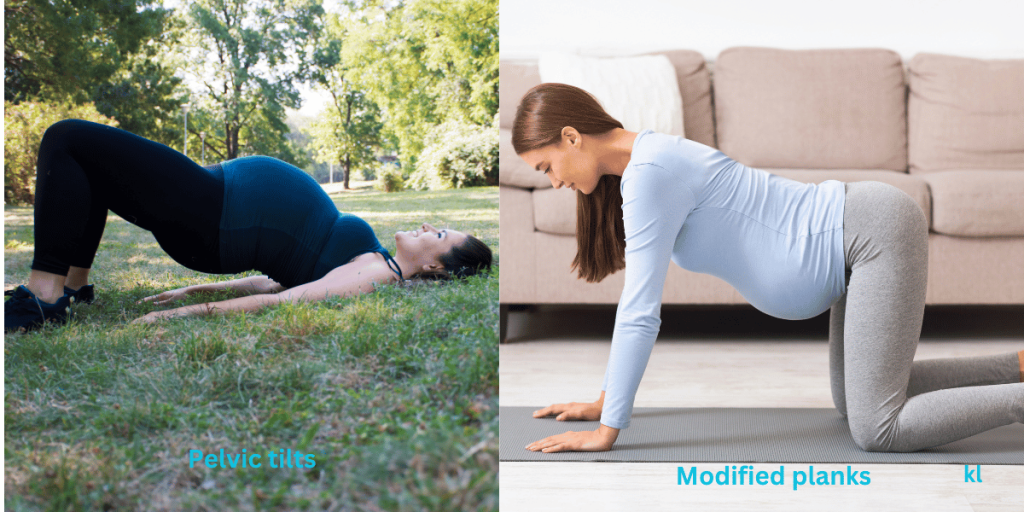
Flexibility, too, is a hidden gem of prenatal workouts. Stretching out the muscles in your hips, back, and legs doesn’t just make you feel more comfortable in the moment, but also preps your body for the physical demands of childbirth.
And let’s not forget the mental health perks. There’s something about moving your body — even on days when the couch seems more appealing — that clears your head, releases pent-up stress, and boosts confidence. Pregnancy can be a rollercoaster of emotions, so having a safe and regular outlet for mental and emotional support is priceless.
Safety First: Guidelines for Exercising While Pregnant
When it comes to exercising during pregnancy, safety is the golden rule. I remember my first trimester and feeling a little anxious about what I should or shouldn’t do. Can I still lift weights? Should I be doing cardio?
Turns out, with a few key guidelines and the green light, staying active can be both safe and hugely beneficial. Let’s dive into some essential tips for safe pregnancy workouts that will keep you feeling strong and energized throughout your pregnancy
Tips for Monitoring Heart Rate and Breathing
One of the most important things I learned was the role of heart rate and breathing in prenatal workouts. When exercising, your body is already working harder to support the baby, so keeping an eye on your heart rate is a must.
A general rule of thumb? Aim for a level where you can still carry on a conversation without gasping for air. It’s called the “talk test,” and it’s pretty effective for staying within a safe range without overdoing it.
Many healthcare providers recommend keeping your heart rate below 140 beats per minute, though it varies depending on your fitness level before pregnancy.
Personally, I found a good heart rate monitor to be a game-changer for peace of mind. Also, listen to your breathing! If you’re huffing and puffing, take a break. Slowing down doesn’t mean you’re not getting a good workout; it just means you’re keeping things safe for you and your baby.

Consulting a Healthcare Provider: An Essential Step
Always consult your healthcare provider before starting or continuing an exercise program during pregnancy.
They can help you understand any personal limitations or adjustments you need to make based on your medical history or pregnancy stage. For instance, I found out that even though I’d been a runner, I needed to swap high-impact runs for more low-impact activities like brisk walking or prenatal yoga.
Your healthcare provider might recommend avoiding exercises that put too much strain on the lower back or abdominal area, especially as your pregnancy progresses.
For those with high-risk pregnancies or specific complications, they may suggest avoiding certain types of workouts altogether. Think of your doctor as part of your fitness team – they’re there to make sure you’re safe and supported.
Modifying Intensity
If you’re unsure about the intensity level, start slow and build up gradually. Pregnancy hormones like relaxin can loosen joints, making you more prone to sprains and strains if you go too hard or too fast.
Low-impact exercises — think swimming, light cycling, or even prenatal aerobics classes — help you get a solid workout without putting too much stress on your body. You can also modify traditional moves like squats and lunges by lowering the weight or using body weight to avoid joint strain.
Safe Postures and Movements to Avoid Joint Strain or Injury
Speaking of joint strain, let’s talk posture. Your center of gravity changes as your belly grows, which can throw you off balance and strain your joints. In the second and third trimesters, it’s a good idea to avoid exercises that require you to lie flat on your back for extended periods, as it can restrict blood flow to both you and the baby.
Exercises like planks or modified side planks can replace back-lying core work, giving you a safer way to strengthen muscles. Keeping movements slow and controlled is another key to prenatal fitness safety.
Moves that require quick shifts or high jumps can throw you off balance, increasing the risk of falls or injury. And trust me, it’s worth skipping out on heavy lifting to avoid putting extra stress on your back. Instead, focus on light weights or resistance bands, which offer great resistance while being gentle on joints

Quick Recap on Safety Tips
Here’s a summary to keep in mind:
Heart rate check: Use the “talk test” to ensure you’re not pushing too hard.
Check with your provider: Especially important if you’re new to working out or have a high-risk pregnancy.
Watch for red flags: If you feel dizzy, short of breath, or experience any cramping, stop and check in with your body.
Posture awareness: Avoid lying flat on your back after the first trimester, and watch your balance in exercises.
Low-impact focus: Activities like swimming, walking, and gentle yoga are perfect for getting a solid workout safely.
First Trimester Exercises: Building a Foundation
Kicking off exercise in the first trimester can feel like stepping into unknown territory. Everything is changing — energy levels, appetite, and maybe even how your body feels just moving around. When I was starting out, I felt that even if I’d been active before, pregnancy added a whole new layer.
If you’re looking to ease into first-trimester exercises, remember that it’s less about going full-throttle and more about gently building a foundation of strength and stability. Here’s how to get started with light cardio, safe strength-building, and breathing techniques to support your core and changing body shape.
Light Cardio Ideas: Walking and Stationary Cycling
Cardio doesn’t have to mean sprints or intense sessions on the treadmill. One of the best parts of early pregnancy is that low-impact prenatal workouts like walking or stationary cycling provide plenty of cardiovascular benefits without the strain.
Walking quickly became my go-to – it is gentle on the body, and walking in nature (or even just around the neighborhood) is a great way to de-stress. Plus, I found that early pregnancy tiredness felt much better when I got a little fresh air.
If you’re up for something indoors, stationary cycling is another great option, especially since balance can start to shift, even in the first trimester especially when fetal development is at a full phase.
You don’t have to push hard; even a slow, steady pace can help maintain your cardiovascular health and boost energy. Both of these options are easy to adjust as needed, whether that means slowing down or taking breaks as you go.
Safe Strength-Building Exercises: Modified Squats, Lunges, and Light Arm Work
Strength-building is the cornerstone of a solid prenatal routine, as it helps prepare your muscles and joints for the changes to come. In the first trimester, low-impact prenatal workouts with a focus on functional movement are ideal.
I loved doing modified squats and lunges, which target the legs and glutes without putting too much pressure on the joints. These exercises will come in handy as they improve balance and support, especially when that center of gravity shifts in later months.
If you’re used to lifting weights, this can be a good time to dial it down a bit. Try lighter weights or even bodyweight exercises for gentle resistance.
Light arm exercises with 3–5 lb. dumbbells (think bicep curls, shoulder presses, or tricep extensions) are perfect for strengthening without overloading.
Maintaining upper body strength is essential because, let’s be real, you’ll be carrying a growing baby in the months to come! And remember, keep movements controlled to avoid any strain.
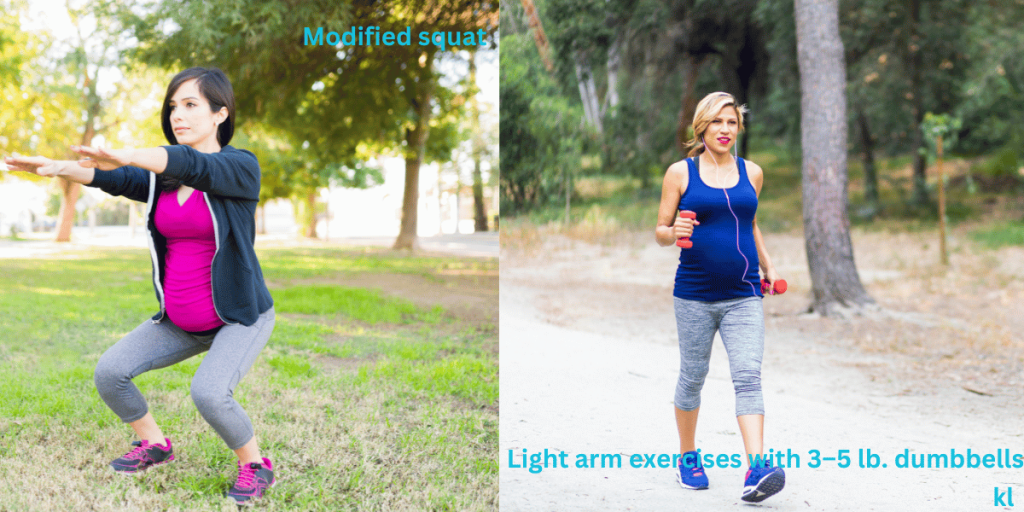
Breathing and Core Exercises to Support Your Changing Body Shape
Breathing exercises sound simple, but they’re surprisingly powerful for supporting the core and changing body shape. Focusing on the breath not only helps to center and relax but is also a low-key way to prepare for labor.
Diaphragmatic breathing, where you breathe deeply into the belly, can be a great place to start. With hands on the belly, inhale slowly, expanding the diaphragm, then exhale completely. This form of breathing encourages oxygen flow, helping you manage stress and energizing you when fatigue hits hard.
Think of these activities as helping you stay strong and steady for each new trimester – because even though you may not notice it yet, your body is gearing up for big changes. And while that sounds like a lot, these small, mindful steps go a long way in supporting both you and your baby.
Also, starting a fitness routine during pregnancy isn’t just about movement; it’s also about fueling your body to keep up with the extra demands. Prenatal vitamins provide vital nutrients, like folic acid, iron, and calcium, which support energy levels and overall health, especially as your body shifts into baby-building mode. So do not forget to take them as we exercise!
Second Trimester Workouts: Maintaining Strength and Balance
The second trimester can be a great time for strength training as it often comes with a boost in energy and a little relief from early pregnancy symptoms. Your body’s doing some serious work now, and strength and balance exercises can make all the difference in managing your growing bump while keeping you active and comfortable.
The key in the second trimester is to focus on safe, weight-bearing moves to build stamina, add in gentle stretching to ease lower back tension and explore modified yoga and Pilates routines to enhance both stability and comfort. Let’s dive into how you can safely maintain strength and balance throughout this trimester.
Introduction to Safe Weight-Bearing Exercises for Stamina
Building stamina through weight-bearing exercises in the second trimester is like a gift to your future self. These moves can keep you feeling strong and help prep your body for the endurance needed in labor.
Simple strength training exercises for pregnant women such as bodyweight squats, stationary lunges, and modified push-ups are ideal. Squats, in particular, are amazing for supporting those muscles in your legs and glutes, and they also help prepare the pelvis for birth (bonus!).
I found stationary lunges especially helpful — they work to stabilize balance as your center of gravity changes.
When it comes to lifting weights, keep it light to moderate; you want to maintain strength, not break any records here. Stick with lighter dumbbells (3–10 pounds depending on your previous fitness level) and perform controlled movements.

Stretching for Flexibility and Reducing Lower Back Tension
Stretching is your best friend in the second trimester. Your body is literally making space, so stretching regularly can help maintain flexibility and relieve tension — especially in the lower back, which tends to bear a lot of the extra load.
Try incorporating gentle, trimester-specific stretches to target problem areas. I personally loved seated forward bends (with legs open to accommodate your belly) and gentle spinal twists.
The cat-cow stretch from yoga is another winner for pregnancy. On all fours, arch your back as you inhale and drop it as you exhale — this movement is soothing and gently stretches and strengthens the lower back. A tip? Pair these stretches with deep, slow breaths to relax further and relieve stress.
For the hips and inner thighs, seated butterfly stretches are excellent. Sit with your feet together and knees apart, and gently press down on your knees. This stretch improves hip flexibility, which is super helpful as you prepare for delivery.
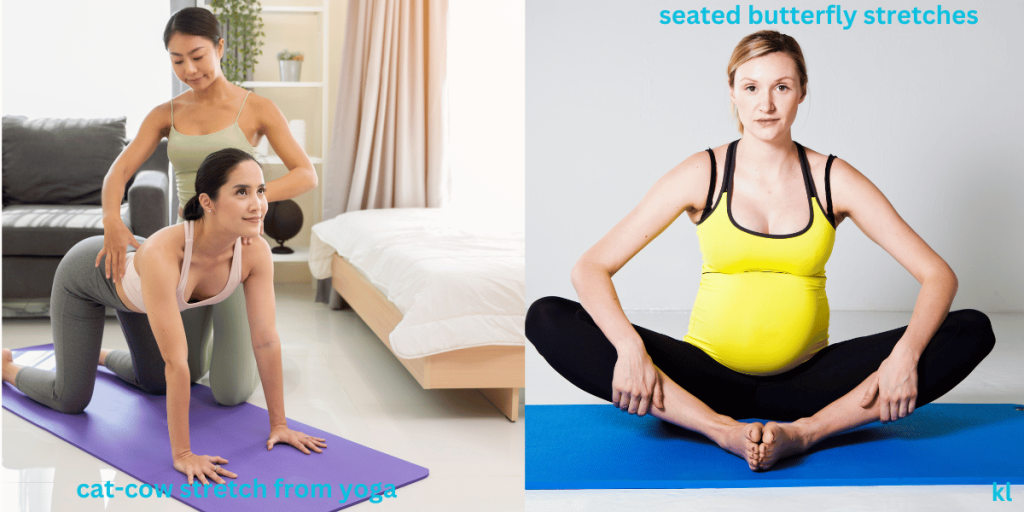
Modified Yoga and Pilates Routines to Enhance Stability and Comfort
Yoga and Pilates are incredibly helpful in this trimester as they work not only to strengthen but also to enhance stability and comfort as your belly grows.
The moves are slow, deliberate, and easily modified to fit your changing body. For instance, try a modified warrior pose: Step one foot forward into a lunge, and keep your back leg straight. This position builds leg strength and challenges your balance in a way that feels supportive.
One of my favorite second-trimester moves is a modified plank. This version of the plank still works the core and helps strengthen the arms without overstressing the abdomen, which becomes increasingly important as your bump grows.
When it comes to Pilates, focusing on moves that strengthen the core and pelvic floor is key. Think of gentle pelvic tilts on a mat or on a small stability ball, or bridges where you lie on your back, lift your hips, and squeeze your glutes — just be sure to limit time on your back as your belly grows.
These exercises support your posture, alleviate some of that lower back discomfort, and help keep your core strong in a safe, non-invasive way.
One thing I can’t stress enough is to listen to your body. Trimester-specific exercises are there to guide you, but every pregnancy is different, so always check in with yourself.
If you’re ever unsure about a move or feel any discomfort (especially in the back or abdomen), it’s a good idea to modify or stop altogether. Keeping hydrated, avoiding sudden movements, and paying attention to breathing are all small but impactful ways to keep your workouts safe and effective.
Third Trimester Exercises: Focusing on Comfort and Mobility
The third trimester is all about managing the little discomforts that come with the final stretch of pregnancy. During this time exercise can be a relief, especially with low-impact moves and stretches focused on comfort and mobility.
This is the time to focus on flexibility exercises for pregnancy to keep things feeling loose, third-trimester stretches to alleviate muscle tension, and mobility exercises to help your body prepare for labor and delivery. Here’s a look at the best exercises I’ve found to maintain comfort and ease some of those third-trimester aches.
Low-Impact Exercises to Maintain Stamina
In the third trimester, gentle, low-impact exercises can keep your stamina up without putting too much strain on your joints. Water aerobics, for instance, is a lifesaver in these last months — the water supports your weight, making it easy on your body, while also allowing you to move freely without any impact on your joints.
If you have access to a pool, try simple water walking, leg lifts, or even gentle squats in the water. It’s refreshing, relieves pressure, and provides a nice cardio boost.
Walking is another low-impact option for maintaining stamina, especially when paired with a comfortable support band. Keeping up with short walks, even if just around the block, helps keep your energy levels stable and circulation flowing.
For those who prefer an indoor activity, a stationary bike at a low resistance setting can provide a similar effect with great cardio benefits.
Hip-Opening Stretches and Pelvic Tilts for Easier Delivery
In these last weeks, hip-opening stretches and pelvic tilts are incredibly beneficial. Think of these moves as prepping your body to be open and ready for delivery. A few great options are seated wide-legged stretches or the butterfly stretch.
Pelvic tilts are another must. To do these, get on all fours, round your back as you inhale (think of arching like a cat), and then relax it back down as you exhale.
This movement strengthens your pelvic floor, alleviates lower back pain, and helps keep your core engaged. You can also do pelvic tilts while seated on a stability ball for some extra support. These are not only helpful for flexibility but can also make delivery a bit easier as your body opens up.
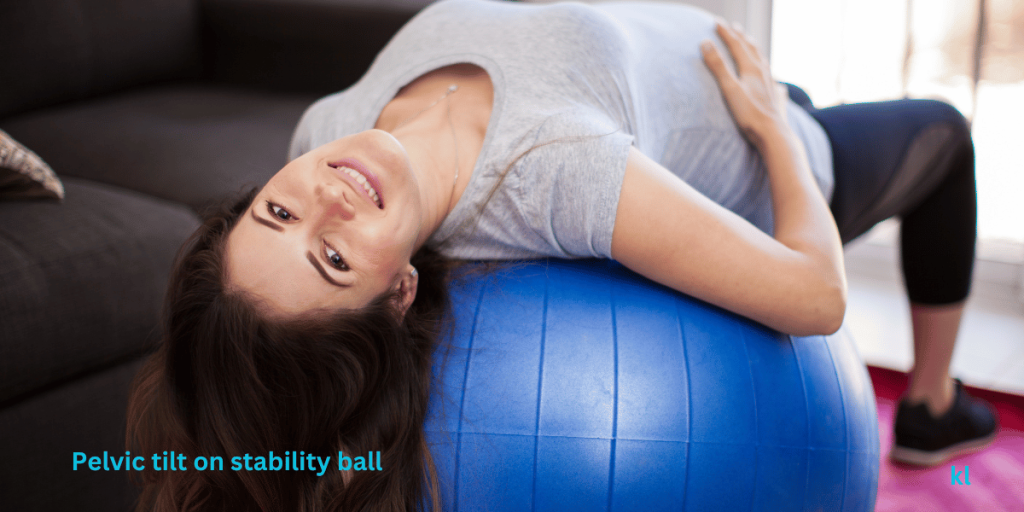
Tips for Posture and Body Alignment as Body Weight Increases
One thing many of us experience in the third trimester is a shift in body alignment. As your belly grows, your weight naturally pulls forward, which can mess with your posture, causing back pain and even making it hard to breathe sometimes.
Good posture and alignment become essential here. Exercises that keep the spine straight and lengthened, like a standing stretch against a wall or gentle wall sits, can offer a lot of relief. When doing a wall sit, make sure your back is fully pressed to the wall, knees at a gentle bend, and hold for a few breaths.
One of the best pieces of advice I ever received for this trimester was to stay mindful of the way I stand and walk. Imagine you’re lengthening your spine and pulling your shoulders back. This small adjustment helps align your body properly, relieving tension and preventing the added weight from straining your back further.
Modifications for Common Pregnancy Discomforts
Pregnancy comes with its share of aches, pains, and unexpected twinges—trust me, I remember all too well! But a few simple exercise modifications can make a huge difference.
If you’re struggling with lower back pain, sciatica, swelling, or just general fatigue, the right movements and adjustments can offer some much-needed relief. Here’s a breakdown of effective exercise modifications that have helped me and others manage common pregnancy discomforts.
Flexibility Exercises for Sciatica and General Discomfort
If you’re experiencing sciatica, you’re definitely not alone. Sciatica pain is common in pregnancy, especially as the weight of the baby starts pressing on your lower back and hips. Stretching exercises, like the figure-four stretch, can work wonders for sciatica pain relief.
Lie on your back with one foot on the floor, bring the opposite ankle over the thigh, and gently pull the bent leg toward your chest. This stretch targets your glutes and piriformis muscles, which can relieve sciatic nerve pressure.
Another helpful stretch is a gentle seated spinal twist. Sit on the floor with legs crossed, place one hand on the opposite knee, and twist gently to each side. This helps release tightness in the lower back and allows you to stretch areas that are harder to reach with a big belly!

Movements to Reduce Swelling and Boost Circulation
Swelling, especially in the legs and feet, is another common issue during pregnancy. Standing or sitting for long periods can make it worse, so adding some circulation-boosting exercises can really help. I’d start with ankle circles and toe taps to get the blood moving.
These can be done sitting or lying down—just circle each ankle 10-15 times in each direction and then flex and point your toes. These small movements help improve circulation, and they’re easy to do even when you’re just relaxing on the couch.
Another great option is to add light walking to your daily routine. Walking not only gets the blood flowing but also keeps your energy levels up, which can help combat pregnancy fatigue.
Just make sure to wear supportive shoes and take breaks if needed! You can also try gentle prenatal yoga stretches that encourage blood flow and reduce tension like a child’s pose or wide-legged forward bends.
Tips for Combating Fatigue and Adjusting Routines as Needed
Fatigue can hit hard, especially as you progress through your pregnancy. There were days when even a short workout felt impossible, so I learned to modify my exercise routines. Start with low-impact exercises like light cardio or gentle stretching.
A 10-minute session of simple movements is sometimes all you need to feel a bit more energized. Remember, it’s okay to skip a workout if you’re exhausted—rest is just as important as exercise.
Incorporating pelvic floor strengthening during pregnancy can be helpful as well, especially as your body preps for labor. Think of exercises like Kegels or gentle squats to engage and strengthen your pelvic floor muscles. These are great for building stamina and resilience in a way that won’t drain your energy.
Another essential tip for managing fatigue is adjusting your posture and focusing on posture support during pregnancy. As your belly grows, it’s easy to slouch, which can put added pressure on your back and shoulders.
Try standing tall with your shoulders relaxed and slightly rolled back. Practicing good posture can relieve muscle strain and make you feel more alert, too!
Best Prenatal Equipment for Safe Workouts
Having the right prenatal equipment could make all the difference in your workout routine. I remember the first time I tried using a stability ball—it felt like a game-changer!
Not only did it provide excellent support for my growing belly, but it also engaged my core and improved my balance. So, let’s dive into some of the best prenatal equipment you can invest in for safe workouts that keep you active and comfortable during this special time.
Recommended Equipment: Stability Balls, Resistance Bands, Light Weights, Belly brace, Prenatal yoga mat
First up is the stability ball. This beauty is more than just a big, bouncy toy. Sitting on a stability ball can help improve your posture and relieve some of the strain on your back, especially as your body changes.
Plus, you can incorporate it into various exercises—think gentle squats or pelvic tilts. Just make sure to choose a size that suits your height! If you’re under 5’5”, a 55 cm ball is typically perfect, while those over 5’5” might want to opt for a 65 cm ball.
Resistance bands are another fantastic tool in the prenatal fitness equipment arsenal. They’re lightweight, portable, and perfect for those resistance band exercises for pregnancy. You can easily adjust the intensity by using different bands or altering the length of the band.
These bands can help you perform a range of exercises to strengthen your arms, legs, and core without straining your joints. My go-to was doing seated rows and lateral leg lifts. It felt good to keep my strength up without overdoing it!
And let’s not forget about lightweights. While it might be tempting to throw caution to the wind and pick up those hefty dumbbells, it’s best to stick with lighter options—think 2-5 pounds.
Lifting lighter weights with proper form helps maintain strength while minimizing the risk of injury.
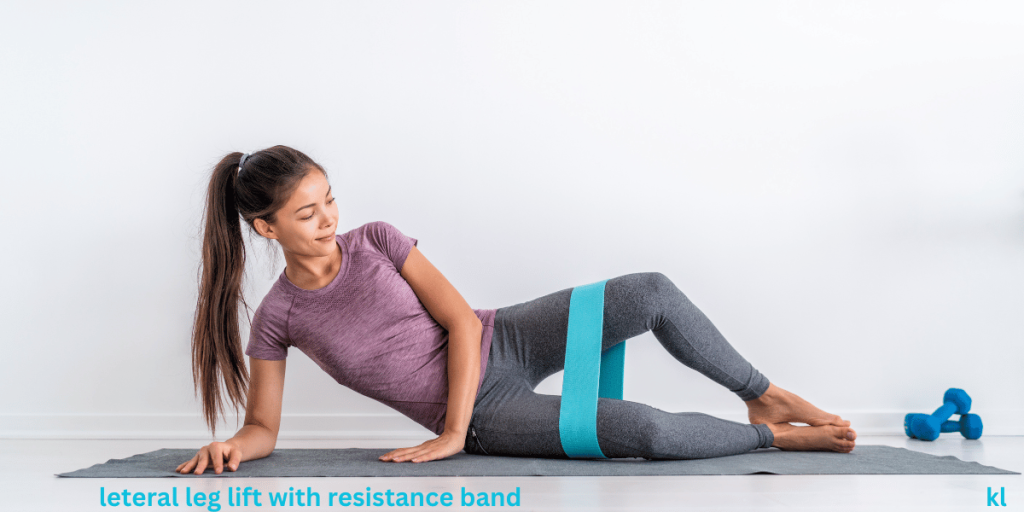
Speaking of belly support, a good maternity support band or belly brace is an absolute must-have, especially in the third trimester when your little one is really starting to stretch you out. I found that extra stability and compression made a world of difference, whether I was walking, doing prenatal Pilates, or just moving around the house.
And if you have the space, a prenatal yoga mat is also a really smart investment. Not only does it provide cushioning and grip for all your floor-based exercises, but it also gives you a designated “zen zone” for those restorative flow sessions. I used mine all the time, both for my at-home workouts and when I attended prenatal fitness classes.
Advantages of Supportive Clothing
First up, the obvious one – maternity workout clothes. I know, I know, it can be tempting to just keep squeezing into your old leggings and sports bras. But let me tell you, Investing in a good pair of maternity leggings and supportive sports bras can truly make a difference in your comfort level while working out.
I remember trying to wear my old workout gear and feeling like I was constricting my belly—not a pleasant experience! Maternity leggings are designed to provide the support you need, with extra room for your growing bump. They also help with compression, which can be beneficial for circulation.
Don’t forget about supportive footwear! A good pair of sneakers with proper arch support can help prevent foot and back pain, making all the difference during workouts.
Setting Up a Safe, Comfortable Workout Space
Creating a dedicated workout space at home can really enhance your prenatal fitness experience. I transformed a corner of my living room into a mini gym with just a few essentials.
Lay down an exercise mat for added comfort, and ensure that your space is free of clutter to avoid any trips or falls. If you can, position your workout area near a window or a well-lit spot to create a more inviting atmosphere. It’s also helpful to keep your equipment easily accessible.
Incorporate a speaker or a Bluetooth speaker to play some upbeat music or a favorite prenatal yoga video. Setting the mood can make your workout feel less like a chore and more like a fun activity.
When to Avoid or Stop Prenatal Exercise
First off, if you ever feel dizziness, shortness of breath, or chest pain, please stop exercising immediately! It’s essential to prioritize your safety over sticking to a routine. Other warning signs include unusual swelling (especially in your hands or face), persistent headaches, or any kind of vaginal bleeding. If you notice any of these, it’s best to consult your healthcare provider before resuming your workouts.
Another common issue is pain, especially in your back or pelvis. While some discomfort is normal as your body changes, severe pain is not something to ignore. During my second trimester, I started experiencing some serious lower back pain after certain workouts.
It turned out that some of my movements were putting too much strain on my body. Listening to your body and modifying or halting activity is crucial to avoiding injury in prenatal workouts.
Adjusting Intensity Based on Fatigue, Hydration, or Symptoms
Let’s talk about fatigue and hydration—two factors that can heavily influence your ability to exercise during pregnancy. Some days you’ll feel like a million bucks, while others might leave you utterly drained. I learned to check in with myself regularly.
If I felt unusually fatigued, I would swap out high-impact workouts for gentler options like walking or prenatal yoga. Trust me, your body is constantly changing, and it’s essential to adjust your workout intensity based on how you’re feeling that day.
Staying hydrated is also a key player in keeping your energy levels up and your body functioning well during workouts. Dehydration can lead to fatigue and dizziness, which can be dangerous.
Always have a water bottle handy during your workouts, and don’t hesitate to take breaks to rehydrate. I found that drinking water before and after exercising made a world of difference in how I felt throughout the day.
When to Consult a Healthcare Provider About Discomfort
If you find yourself experiencing discomfort that doesn’t ease up after a few days, it might be time to reach out to your healthcare provider.
You should also keep your doctor in the loop about your exercise routine, especially if you have any pre-existing conditions or complications. They can provide valuable pregnancy workout safety tips that cater to your specific needs, ensuring that you’re exercising safely.
Pregnancy is such an incredible journey, and staying active is a wonderful way to support your body and your baby. Remember to adjust your workouts based on how you feel and consult with your healthcare provider if you have any concerns.
The key is to stay flexible with your routine—listen to your body, and have fun with it! Each trimester presents its challenges and joys, and finding a workout routine that fits will help you embrace every moment of this special time. So get moving and enjoy the ride!

